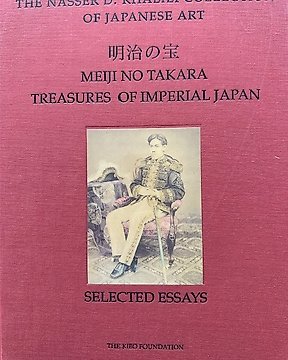
The Kibo Foundation - The Nasser D.Khalili Collection of Japanese Art, Meiji No Takara, Treasures of Imperial Japan - 1995
编号 84395015

编号 84395015

The Nasser D.Khalili Collection of Japanese Art, Meiji No Takara, Treasures of Imperial Japan, Enamel,Volume III,320 pages,1994 and Lacquer,Part I,Volume IV, 255 pages,1995, The Kibo Foundation
The Khalili Collection of Japanese Art is a private collection of decorative art from Meiji-era (1868–1912) Japan, assembled by the British-Iranian scholar, collector and philanthropist Nasser D. Khalili. Its 1,400 art works include metalwork, enamels, ceramics, lacquered objects, and textile art, making it comparable only to the collection of the Japanese imperial family in terms of size and quality. The Meiji era was a time when Japan absorbed some Western cultural influences and used international events to promote its art, which became very influential in Europe. Rather than covering the whole range of Meiji-era decorative art, Khalili has focused on objects of the highest technical and artistic quality. Some of the works were made by artists of the imperial court for the Great Exhibitions of the late 19th century. The collection is one of eight assembled, published, and exhibited by Khalili.
Although the collection is not on permanent public display, its objects are lent to cultural institutions and have appeared in many exhibitions from 1994 onwards. Exhibitions drawing exclusively from the collection have been held at the British Museum, Israel Museum, Van Gogh Museum, Portland Museum, Moscow Kremlin Museums, and other institutions worldwide.
The collection is one of eight assembled by Nasser D. Khalili, each of which is considered among the most important in its field. Three of them include works from Japan: the collection of Japanese art, the Khalili Collection of Kimono, and the Khalili Collection of Enamels of the World. Khalili observed that Japanese arts were less well-documented than European arts of the same period, despite being technically superior: "Whilst one could argue it is relatively easy to replicate a Fabergé, to replicate the work of the Japanese master is nigh on impossible." As well as assembling these collections, Khalili founded the Kibo Foundation (from the Japanese word for "hope") to promote the study of art and design of the Meiji era, publishing scholarship about the collection and its historical context.
Meiji No Takara – Treasures of Imperial Japan
Enamel,VOLUME III
Oliver Impey and Malcolm Fairley with a contribution by Jack Hillier
Published 1994
Japanese cloisonné enamels were a technical triumph of the Meiji (1868–1912) and Taisho (1912–26) periods, and the 107 examples (of near-300 in the collection) reproduced in this volume offer an unrivalled panorama of achievement centred around the work of three artists: Namikawa Yasuyuki, Namikawa Sosuke, and Ando Jubei.
The Collection includes a large number of works by each of them, making it possible to establish the first reliable chronology for the development of enamelling in Japan.
An introductory essay traces the history of the craft from the first experiments of Kaji Tsunekichi in the 1840s and 1850s and identifies three strands of stylistic evolution that took place from the 1860s; the conservative, the pictorial and the exotic.
An essay by the great British scholar Jack Hillier traces the relationship between Sosuke and the painter Watanabe Seitei.
This volume, combining magnificent colour reproduction with pioneering scholarship, will serve as the essential guide to a little-known facet of Japan’s artistic achievement.
Details
320 pages; fully illustrated in colour; 40 x 30 cm; hardback with slipcase; 1994; ISBN: 978-1-874780-03-8
Meiji No Takara – Treasures of Imperial Japan
Lacquer Part One,VOLUME IV
Authors/Contributors: Oliver Impey, Malcolm Fairley and Joe Earle with contributions by Goke Tadaomi, Julia Hutt and Edward Wrangham
Published 1995, fully illustrated in colour; 40 x 30 cm; hardback with slipcase; 1995; ISBN: 978-1-874780-04-5
Due to strong continuities of type and style in this most characteristically Japanese of arts, the first of the two parts making up this volume includes several pieces dating from the 17th to the 19th century.
The revival of the classical style is covered in depth, with major works by such revered figures as Nakayama Komin (1808–70) and Shirayama Shosai (1853–1923) and there is a large group of examples of shibayama work which combines lacquer with other materials to create a rich and exotic effect.
The centrepiece of the Collection is an extravagantly decorated cabinet by Harui Komin (b. 1869) presented by the Japanese Crown Prince to the future King Edward VIII of England in 1921.
An introductory essay by Julia Hutt of the Victoria and Albert Museum chronicles the development of lacquer in response to Western demand, while Edward Wrangham, one of the world’s foremost lacquer collectors, contributes an article on the Rimpa style.